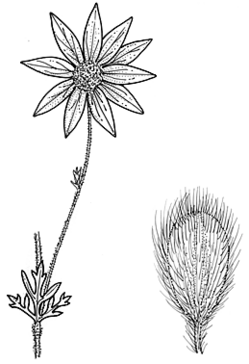Common name: Flannel Flower
Actinotus helianthi Labill. APNI* 
Description: Erect annual or perennial herb, usually 30–90 cm high, the whole plant woolly with the indumentum almost floccose.
Leaves biternately divided; lamina to c. 50 mm long and wide; segments linear or oblong-linear, 15–30 mm long, c. 5 mm wide, usually grey-green, tomentose; petiole 8–50 mm long.
Umbels head-like, 12–20 mm diam., surrounded by bracts; whole inflorescence 2.5–8 cm diam.; peduncle stout to 8 cm long; bracts 10–18, 2–4 cm long, white or creamy tomentose tipped green; pedicels 3–4 mm long. Flowers white to creamish, outer ones male, inner bisexual. Sepals linear, small. Petals absent.
Fruit ovate, 3.2–5 mm long, 1.8–2.8 mm wide, covered with long silky hairs.
Flowering: throughout year, mainly September–November
Distribution and occurrence: Grows in coastal heath and scrub, open eucalypt forest on shallow sandy soils, often in exposed situations, widespread, north from Nerriga-Ulladulla district and west to Narrabri.
NSW subdivisions: NC, CC, SC, NT, CT, ST, NWS, CWS, NWP
Other Australian states: Qld
Text by J. M. Powell, except for genera with authors listed
Taxon concept: Flora of NSW 3 (1992)
APNI* Provides a link to the Australian Plant Name Index (hosted by the Australian National Botanic Gardens) for comprehensive bibliographic data
***The AVH map option provides a detailed interactive Australia wide distribution map drawn from collections held by all major Australian herbaria participating in the Australian Virtual Herbarium project.
|


